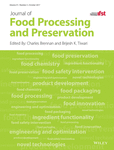Functional, physiological, and rheological properties of oat β-glucan oxidized with hydrogen peroxide under soft conditions
Funding information: FAPERGS; CAPES; CNPq; SCT-RS; Pole of Technological Modernization of the Southern Region Food
Abstract
The β-glucan fiber has been used to change the consistency, water activity, and fat binding capacity (FB), promoting viscosity, gelification or emulsification, in foods. Its properties are related to their structure, which can be modified chemically, enzymatically, and physically. The objective of this study was to evaluate the effect of oxidation under soft conditions (0.05 mL 100 g−1 and 0.10 mL 100 g−1 H2O2 for 10 and 20 min) on the functional, thermal, and rheological properties of oat β-glucan. The soft oxidation of β-glucan at higher levels of oxidant increased the power of swelling and bile acids binding capacity, resulting in a higher hypocholesterolemic effect. In the same levels, the texture profile of oxidized β-glucans gels showed a reduction in hardness and lack of adhesiveness, as well as an increase in springiness and gumminess. The viscosity of β-glucan decreased after oxidation and showed pseudoplastic behavior.
Practical applications
β-glucan solutions can easily suffer molecular breakdown due to different processes, which may alter the effectiveness of health benefits due to their relationship with the viscosity. Among the possible modifications to which polysaccharides like β-glucan may be submitted, oxidation stands out. Studies on oxidation of β-glucan has been carried out using hydrogen peroxide as an oxidizing agent and iron ions as a catalyst, under conditions of concentration and temperature variables. However, there are no studies of oxidation of β-glucan under soft reaction conditions, with the purpose of improving physiological properties.




